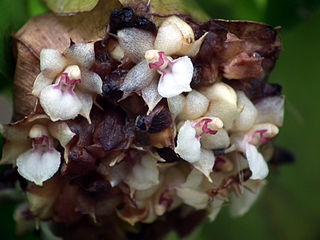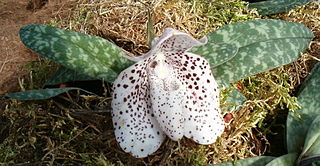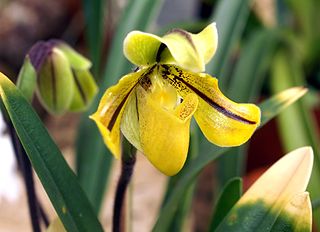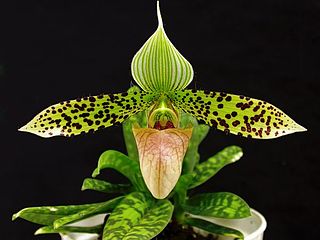
Cypripedioideae is a subfamily of orchids commonly known as lady's slipper orchids, lady slipper orchids or slipper orchids. Cypripedioideae includes the genera Cypripedium, Mexipedium, Paphiopedilum, Phragmipedium and Selenipedium. They are characterised by the slipper-shaped pouches of the flowers – the pouch traps insects so they are forced to climb up past the staminode, behind which they collect or deposit pollinia, thus fertilizing the flower. There are approximately 165 species in the subfamily.

Paphiopedilum, often called the Venus slipper, is a genus of the lady slipper orchid subfamily Cypripedioideae of the flowering plant family Orchidaceae. The genus comprises some 80 accepted taxa including several natural hybrids. The genus is native to Southeast Asia, the Indian Subcontinent, southern China, New Guinea and the Solomon and Bismarck Islands. The type species of this genus is Paphiopedilum insigne.

Aerides, known commonly as cat's-tail orchids and fox brush orchids, is a genus belonging to the orchid family. It is a group of tropical epiphyte orchids that grow mainly in the warm lowlands of tropical Asia from India to southern China to New Guinea. They are valued in horticulture for their racemes of showy, fragrant, colorful flowers.

Agrostophyllum is a genus with about ninety species from the orchid family (Orchidaceae). The genus name is derived from the Greek words agrostis ("grass") and phyllos ("leaf"), referring to the grass-like appearance of the leaves of some species.

Arundina graminifolia is a species of orchid and the sole accepted species of the genus Arundina. This tropical Asiatic genus extends from Myanmar, India, Sri Lanka, Nepal, Thailand, Vietnam, the Ryukyu Islands, Malaysia, Singapore, China to Indonesia, the Philippines and New Guinea. It has become naturalized in Réunion, Fiji, French Polynesia, Micronesia, the West Indies, Costa Rica, Panama, Belize, and Hawaii. It is also called bamboo orchid.

Paphiopedilum rothschildianum, it is commonly known as the Gold of Kinabalu orchid or Rothschild's slipper orchid, is a large sized clear-leafed species of orchid. It blooms with a tall inflorescence with up to six, large flowers. It is unique in the Corypetalum group by holding its petals almost horizontally, giving the flower a very distinctive appearance. The peak flowering period is from April to May.

Acriopsis, commonly known as chandelier orchids or 合萼兰属 is a genus of flowering plants in the family Orchidaceaes. Orchids in this genus are epiphytic herbs with spherical or cylindrical pseudobulbs, creeping, branched rhizomes, thin white roots, two or three leaves and many small flowers. The flowers are non-resupinate with the lateral sepals joined along their edges and have spreading petals and a three-lobed labellum. The column has projections that extend hood-like beyond the anther.

Gastrodia, commonly known as potato orchids or as 天麻属 , is a genus of terrestrial leafless orchids in the family Orchidaceae, about ninety of which have been described. Orchids in this genus have fleshy, upright stems and small to medium-sized resupinate flowers with narrow sepals and petals. They are native to Asia, Australia, New Zealand, central Africa, and various islands of the Indian and Pacific Oceans.

Paphiopedilum fowliei is a species of plant in the family Orchidaceae. It is endemic to Palawan in the Philippines. Its natural habitat is subtropical or tropical moist lowland forests. It is threatened by habitat loss.

Dipodium, commonly known as hyacinth orchids, is a genus of about forty species of orchids native to tropical, subtropical and temperate regions of south-east Asia, New Guinea, the Pacific Islands and Australia. It includes both terrestrial and climbing species, some with leaves and some leafless, but all with large, often colourful flowers on tall flowering stems. It is the only genus of its alliance, Dipodium.

Paphiopedilum bellatulum, commonly known as the egg-in-a-nest orchid, is a species of orchid found from southeastern Yunnan, Guizhou and southern Guangxi of China to Indochina. It is also found in Myanmar and Thailand at an altitude of 1,000 to 1,800 meters. The leaves are a dark green with white spots on top, but the underside is purple. The flower is round, about 6–8 cm in diameter.

Paphiopedilum callosum is a species of orchid found from Vietnam to northwestern Peninsular Malaysia. It has been investigated and shown promising results in the treatment of cancer.

Paphiopedilum druryi is a species of orchid endemic to the Agastyamalai Hills of southern India. It is the only southern Indian orchid species in the genus. Rediscovered in 1972 after its original description in 1870, wild populations were decimated by commercial collectors and it is one of the few plants that are listed as threatened by the Indian government and included in CITES and the IUCN Redlist.

Paphiopedilum exul is a species of orchid endemic to peninsular Thailand. This orchid is found growing in humus-filled crevices, and is not difficult to grow or flower. Its greenish yellow flowers appear from February to May.

Paphiopedilum godefroyae is a species of orchid endemic to peninsular Thailand, Vietnam and Malaysia. This species is found just above sea level on limestone cliffs. The flowers are around 9 cm across, creamy white to light green. They flower from December to July.

Paphiopedilum insigne is an Asian species of slipper orchid and the type species of the genus Paphiopedilum. Its name is derived from the Latin insigne, meaning 'badge of honor' due to the magnificent flower. In the 19th century it was very popular among European and American orchid growers, causing it to become very rare in the wild due to over collecting. There are many varieties of it and hybrids with it.

Paphiopedilum sanderianum is a rare species of orchid endemic to northwestern Borneo. First discovered in 1885 by F. Sander's collector, J. Foerstermann, the orchid became renowned for the remarkable length of its petals, which can measure over 1 meter long. Although P. sanderianum has been used as a parent in a number of crosses, none of the resulting hybrids have so far matched the extraordinary lengths of this species' petals. However, soon after the turn of the 20th century, this rare orchid was lost to cultivation and thought to be extinct in the wild, until its rediscovery in 1978 by Ivan Nielson. The wild population of Paphiopedilum sanderianum grows protected in Gunung Mulu National Park.

Paphiopedilum sukhakulii is a species of plant in the family Orchidaceae.

Paphiopedilum parishii is a species of orchid found in northern and western Thailand, Laos, Myanmar, Yunnan and Assam, in montane forests at 1200–2200 m above sea level. It is named after Charles Samuel Pollock Parish, an English botanist and avid plant collector who had a particular interest in the flora of Myanmar.

Paphiopedilum thaianum is a species of orchid endemic to peninsular Thailand. It was initially described by Prapanth Iamwiriyakul in 2006.




















